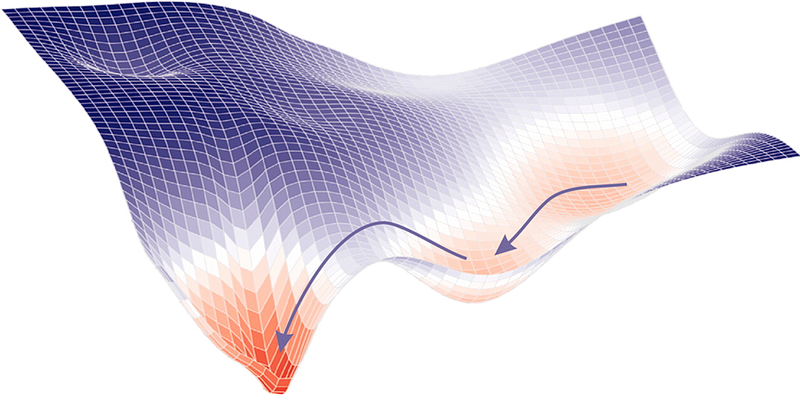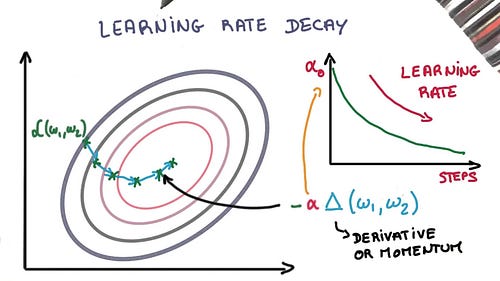Difference between revisions of "Gradient Descent Optimization & Challenges"
m |
m |
||
| Line 51: | Line 51: | ||
<youtube>2GNbIKTKCfE</youtube> | <youtube>2GNbIKTKCfE</youtube> | ||
| + | |||
| + | = <span id="Learning Rate Decay"></span>Learning Rate Decay = | ||
| + | |||
| + | Adapting the learning rate for your stochastic gradient descent optimization procedure can increase performance and reduce training time. Sometimes this is called learning rate annealing or adaptive learning rates. The simplest and perhaps most used adaptation of learning rate during training are techniques that reduce the learning rate over time. These have the benefit of making large changes at the beginning of the training procedure when larger learning rate values are used, and decreasing the learning rate such that a smaller rate and therefore smaller training updates are made to weights later in the training procedure. This has the effect of quickly learning good weights early and fine tuning them later. [http://medium.com/cracking-the-data-science-interview/the-10-deep-learning-methods-ai-practitioners-need-to-apply-885259f402c1 The 10 Deep Learning Methods AI Practitioners Need to Apply | James Le] | ||
| + | |||
| + | Two popular and easy to use learning rate decay are as follows: | ||
| + | * Decrease the learning rate gradually based on the epoch. | ||
| + | * Decrease the learning rate using punctuated large drops at specific epochs. | ||
| + | |||
| + | http://miro.medium.com/max/500/1*jzIVDhOzzrHV9m8cEsTiSA.jpeg | ||
Revision as of 07:52, 25 September 2020
YouTube search... ...Google search
- Gradient Boosting Algorithms
- Backpropagation
- Objective vs. Cost vs. Loss vs. Error Function
- Topology and Weight Evolving Artificial Neural Network (TWEANN)
- What is Gradient Descent? | Daniel Nelson - Unite.ai
- Other Challenges in Artificial Intelligence
- Average-Stochastic Gradient Descent (SGD) Weight-Dropped LSTM (AWD-LSTM)

Gradient descent is an optimization algorithm used to minimize some function by iteratively moving in the direction of steepest descent as defined by the negative of the gradient. In machine learning, we use gradient descent to update the parameters of our model. Parameters refer to coefficients in Linear Regression and weights in neural networks. Gradient Descent | ML Cheatsheet
Gradient Descent is the most common optimization algorithm in machine learning and deep learning. It is a first-order optimization algorithm. This means it only takes into account the first derivative when performing the updates on the parameters. On each iteration, we update the parameters in the opposite direction of the gradient of the objective function J(w) w.r.t the parameters where the gradient gives the direction of the steepest ascent. Gradient Descent Algorithm and Its Variants | Imad Dabbura - Towards Data Science
Nonlinear Regression algorithms, which fit curves that are not linear in their parameters to data, are a little more complicated, because, unlike linear Regression problems, they can’t be solved with a deterministic method. Instead, the nonlinear Regression algorithms implement some kind of iterative minimization process, often some variation on the method of steepest descent. Steepest descent basically computes the squared error and its gradient at the current parameter values, picks a step size (aka learning rate), follows the direction of the gradient “down the hill,” and then recomputes the squared error and its gradient at the new parameter values. Eventually, with luck, the process converges. The variants on steepest descent try to improve the convergence properties. Machine learning algorithms are even less straightforward than nonlinear Regression, partly because machine learning dispenses with the constraint of fitting to a specific mathematical function, such as a polynomial. There are two major categories of problems that are often solved by machine learning: Regression and classification. Regression is for numeric data (e.g. What is the likely income for someone with a given address and profession?) and classification is for non-numeric data (e.g. Will the applicant default on this loan?). Machine learning algorithms explained | Martin Heller - InfoWorld
Contents
[hide]Gradient Descent - Stochastic (SGD), Batch (BGD) & Mini-Batch
Vanishing & Exploding Gradients Problems
Vanishing & Exploding Gradients Challenges with Long Short-Term Memory (LSTM) and Recurrent Neural Networks (RNN)
Learning Rate Decay
Adapting the learning rate for your stochastic gradient descent optimization procedure can increase performance and reduce training time. Sometimes this is called learning rate annealing or adaptive learning rates. The simplest and perhaps most used adaptation of learning rate during training are techniques that reduce the learning rate over time. These have the benefit of making large changes at the beginning of the training procedure when larger learning rate values are used, and decreasing the learning rate such that a smaller rate and therefore smaller training updates are made to weights later in the training procedure. This has the effect of quickly learning good weights early and fine tuning them later. The 10 Deep Learning Methods AI Practitioners Need to Apply | James Le
Two popular and easy to use learning rate decay are as follows:
- Decrease the learning rate gradually based on the epoch.
- Decrease the learning rate using punctuated large drops at specific epochs.
